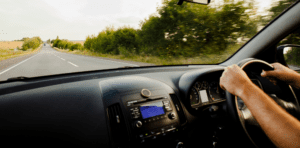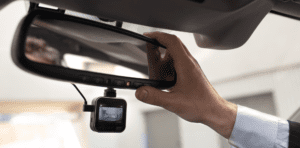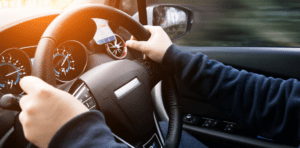Compare cheap car insurance
✔ Compare cheap car insurance quotes
✔ Over 110 insurance providers
✔ Get a quote in minutes
✔ Save up to £504*
Were you aware that there are regulations regarding driving with pets? Breaking these rules and you might face a substantial penalty and points on your driving licence.
- How to drive with pets and keep them safe
- Tips for driving with pets
- The dangers of driving with pets in the car
- Checklist for driving with pets
- When to avoid driving with pets
- Managing travel sickness in dogs
- Laws on driving with dogs in the car
- Driving with pets travel advice
- Driving with pets in the car in hot weather
- Advice on taking pets abroad
- How does driving with a pet in the car affect my car insurance?
- Frequently asked questions
Fear not, our guide provides all the essential information about safely driving with dogs, cats, and various other animals.
How to drive with pets and keep them safe
When embarking on any journey, whether it’s a brief visit to the vets, a leisurely UK staycation, or an extended European summer retreat, there will be times when you’ll need to take your beloved cat or dog along in the car.
The experience of travelling by car can often be disorienting and at times deeply distressing for pets. Therefore, it becomes crucial to ensure they are not only comfortable but also secure throughout the journey. This not only ensures their well-being but also contributes to a smoother and less distracting drive for you.


Moreover, in addition to the comfort and safety of your pet, it’s important to be aware of and adhere to the regulations stipulated by The Highway Code. Specifically, The Highway Code mandates that pets should be appropriately restrained while travelling.
Rule 57
When in a vehicle make sure dogs or other animals are suitably restrained so they cannot distract you while you are driving or injure you, or themselves, if you stop quickly. A seat belt harness, pet carrier, dog cage or dog guard are ways of restraining animals in cars.
This is to ensure they don’t become a source of distraction which could lead to careless driving. It’s also essential to consider that in the event of a sudden stop or an unforeseen incident, an unrestrained pet could be at risk of injury, or could inadvertently cause harm to the vehicle’s occupants.
As a responsible pet owner, ensuring your pet’s safety also means adhering to these regulations, protecting not just your furry companion but also everyone else in the car.
How much can you save on your car insurance?
Tips for driving with pets
Embarking on a journey with your cherished four-legged companion necessitates meticulous planning to ensure their safety and well-being.
Here’s a comprehensive guide on how to achieve this:
Use a crate or carrier
Invest in a robust crate or carrier that adequately secures your pet. Ensure it is spacious enough for your pet to manoeuvre comfortably, being able to stand up and rotate.


A well-ventilated carrier that is firmly strapped in will keep your pet steady and comfortable, preventing unnecessary movement during the drive.
Buy comfortable restraints
Opt for specialised restraints such as harnesses and seat belts, which despite sounding uninviting, can offer a snug fit. These accessories permit limited mobility, allowing your dog to sit upright and make minor movements without compromising safety.
Acclimatise your pet to travel
To mitigate travel anxiety, familiarise your pet with the car environment through short, incremental journeys. This can be particularly beneficial if your pet is prone to travel-related anxiety, preparing them for longer trips.
Monitor your pet frequently
If possible, have a passenger supervise your pet, or alternatively, make periodic stops to assess their condition. Keep an eye out for symptoms such as panting, indicative of overheating or motion sickness.
Avoid leaving your pet unattended in the car
The interior of a car can increase in temperature rapidly, posing a heatstroke risk. Always ensure that your pet is not left alone in the car, as they are susceptible to temperature fluctuations, unlike humans.
Bring food and necessities
Equip yourself with an assortment of necessary items such as food, a bowl, lead, waste bags and medication. It’s advisable to carry surplus supplies to be adequately prepared for unforeseen circumstances or delays.
Keep them hydrated
Having water is paramount. Consider buying specialised bowls resistant to spilling, designed for use in the car, to keep your pet hydrated without any mess.
Don’t let your pet hang their head out of the window
Prevent your pet from protruding their head outside the window to avoid the risk of injury from external debris and in the event of collisions.


It is acceptable to keep the windows slightly ajar for ventilation, ensuring that it doesn’t tempt an adventurous leap outside.
Microchip your pet
To abide by the law, ensure that dogs are microchipped and equipped with an ID tag. It enhances the likelihood of a reunion if they were to get lost.


The microchipping of cats is also advisable for added security, and essential information regarding travel regulations post-Brexit should be sought if travelling abroad is anticipated.
Let them exercise
Incorporate regular stops so your pet can enjoy some exercise and relieve themselves. Use the spaces available at service stations, ensuring you maintain cleanliness by promptly disposing of pet waste.


By following these guidelines, you can ensure that the journey remains a pleasurable and safe experience for both you and your cherished pet.
How much can you save on your car insurance?
The dangers of driving with pets in the car
Ensuring the safety of our beloved pets whilst on the move is paramount. They are cherished members of our families, and it is our responsibility to prevent any harm from befalling them or ourselves.


Unsecured travel with pets in the car can usher in a myriad of potential risks:
A distraction to the driver
An active pet can divert a driver’s attention significantly. This might occur as a result of your pet moving erratically, barking, or engaging in any behaviour that shifts your focus from the task of driving. It’s vital to ensure that your concentration remains solely on the road to avoid any mishaps.
Increased risk of injury
An unrestrained pet is at a heightened risk of injury. In the event of abrupt stops or collisions, an unsecured pet could be projected forward, leading to grave injuries. Such a scenario not only jeopardises the safety of the pet but can also endanger the driver and other occupants of the vehicle, leading to potential harm.
Driving offences
Driving whilst being notably distracted by an unrestrained pet can lead to accusations of careless or even dangerous driving. Such transgressions can culminate in severe repercussions, including hefty fines, endorsement of penalty points on your licence, or even incarceration in extreme instances.
The Highway Code explicitly emphasises the need for animals to be restrained to prevent driver distractions. Furthermore, in the unfortunate event of an accident where your pet is discovered to be unsecured, not only might you face legal consequences, but it could also jeopardise your insurance claim, leaving you financially burdened.
Risk of infections
An often-overlooked aspect of driving with pets, especially dogs, is the allure of open windows. While it appears joyous for dogs to pop their heads out, enjoying the breeze, it exponentially increases their exposure to airborne contaminants. The influx of dirt, dust, and other particles could potentially infiltrate their respiratory and visual systems, leading to infections and complications.
Stress and anxiety
Just as humans can feel uneasy during travel, pets too can experience stress, anxiety or even motion sickness. An unrestrained pet could feel more vulnerable, amplifying their anxiety, which might manifest in unpredictable behaviours. It’s essential to create a comfortable environment for them to minimise these feelings.
Recognising and mitigating these potential hazards ensures that every journey with your furry companion remains safe, comfortable, and enjoyable for all parties involved.
How much can you save on your car insurance?
Checklist for driving with pets
Ensuring the safety and comfort of your beloved pet while travelling is crucial. As you prep for your journey, a few integral considerations can help alleviate potential distress for your furry friend.


Here’s a comprehensive checklist to assist you in creating a hassle-free experience:
Pre-travel pet care: Prioritising your pet’s well-being before setting off is essential:
Exercise: If your pet is particularly energetic, take them for a good walk to drain some of that energy before you go. This will not only calm them down but increase the chances of them resting or napping during the drive.
Meal timing: Feed your pet approximately two to three hours prior to leaving. This ensures they are neither too full nor too hungry, reducing the risk of travel-related nausea.
Hydration and breaks: Ensure your pet is well-hydrated, but not immediately before the journey to prevent discomfort. Also, allocate time for a brief walk, allowing them to relieve themselves, just before you head out.
Create a familiar environment: Your pet’s comfort zone within the car is crucial:
Carrier setup: If you are using a carrier, ensure it’s clean and without any lingering odours. Enhance the comfort by lining it with their favourite blanket or cushion and include familiar toys to offer solace during the journey.
Designated space: For pets harnessed directly to the seat, find a comfortable spot. This could be a padded area or a specific section of the backseat furnished with familiar items.
Secure your pet adequately: Safety restraints are vital for a pet’s security:
- Strap them in: Just as you would with a child, ensure your pet is firmly secured. Whether in a carrier or using a harness, fasten them snugly to avoid any untoward movement, especially during sudden brakes or in case of an accident. This not only guarantees their safety but also aids in minimising potential distractions for the driver.
Travel essentials kit: Pack a small bag with your pet’s necessities:
Water and bowl: Always have a bottle of water and a portable bowl, especially for longer journeys.
Snacks: Carry some light snacks or treats, in case your pet gets hungry during the journey.
First-aid kit: An emergency kit tailored for pets, including essential medications, can be invaluable.
Waste bags and wipes: Ensure you have ample waste disposal bags and sanitising wipes for pit stops and to manage any messes.
By ticking off these considerations, you’re ensuring a more relaxed, safer, and smoother journey for both you and your pet.
How much can you save on your car insurance?
When to Avoid Driving with Pets
Travelling can be an exciting endeavour, but not always for our four-legged companions. Before setting off with your pet, it’s essential to consider their well-being and comfort. Sometimes, taking them with you might not be in their best interest.


Your duty of care to your pet entails ensuring their safety and preventing any undue distress. Here are a few circumstances where it might be more suitable to leave your pet behind:
If your pet is ill: Just as humans may not fare well when travelling under the weather, the same goes for pets. Their comfort and health should be a priority.
If your pet is a newborn: Newborn pets are fragile and require a stable environment. Travel can be jarring and might disrupt their early development stages.
If your pet gave birth within the last 48 hours: This is a critical recovery period, and travelling could place unnecessary stress on both the mother and her newborns.
If your pet is heavily pregnant: The stress of travel could induce premature labour or cause complications during birth.
If, for some pressing reason, you find yourself needing to travel with a pet that’s unwell or under any of the above conditions, follow these recommendations to ensure their safety and comfort:
Medication: Always carry any medications your pet might be on, ensuring they’re current and not past their expiration date.
Medical Records: Having a copy of your pet’s medical records can be invaluable, especially if you need to consult a vet unfamiliar with your pet’s history.
Monitor Comfort Levels: Keep a watchful eye on your pet. Check for signs of distress or discomfort and make necessary adjustments to their environment.
Emergency Contacts: Maintain a list of emergency numbers, including your vet and emergency animal care facilities in the areas you’re travelling through or to.
First Aid Kit: A pet-specific first aid kit can be a lifesaver. Equip it with essentials like bandages, antiseptics, and tweezers.
While the company of our pets is often comforting, it’s crucial to evaluate whether a journey is in their best interest. Always prioritise their well-being and safety above all else.
How much can you save on your car insurance?
Managing travel sickness in dogs
Dogs, much like us, can experience the discomfort of travel sickness due to motion. According to the PDSA, travel sickness manifests itself in dogs through various symptoms.


Recognising these signs early can make a world of difference to your furry friend’s well-being during journeys.
Common Symptoms of Travel Sickness in Dogs
Drooling: Excessive salivation can be a tell-tale sign.
Excessive swallowing: Frequent swallowing can indicate nausea.
Excessive lip licking: Another sign your dog might not be feeling well.
Retching: If your dog is trying to vomit, it’s a clear indication.
Panting: Rapid breathing or panting can be a sign of distress.
If you observe these symptoms in your dog, it is advisable to consult a vet for guidance. Before embarking on any further journeys with your dog, always seek expert medical advice.
Proactive Measures to Prevent Motion Sickness
Feeding Schedule: Ensure your dog eats 2-3 hours before setting out. A full or empty stomach right before a trip can exacerbate nausea.
Pre-travel Exercise: A brisk walk can help your dog release pent-up energy, making the journey more comfortable.
Temperature Control: Make sure the vehicle’s interior isn’t too hot. Overheating can increase the chances of sickness.
Gradual Introduction: Acclimatise your dog to travelling by starting with shorter trips before attempting longer journeys.
Comfortable Seating: Provide a stable and comfy place for your dog to sit or lie down during the trip.
Optimal Orientation: Using a car harness or adapted seatbelt that enables your dog to face forwards can help them anticipate the motion, thus reducing unease.
Regular Breaks: Stop periodically for breaks, allowing your dog to stretch, hydrate, and relieve themselves.
Remember, keeping your dog safe and secure during a journey not only ensures their comfort but also maintains their balance, reducing the likelihood of motion sickness.
For severe cases, consult with your vet about potential prescription remedies tailored for dogs. It’s crucial not to administer human motion sickness medicines to pets.
These are not formulated for dogs and might not only be ineffective but could also lead to serious health complications. Always prioritise your pet’s health and well-being when travelling.
How much can you save on your car insurance?
Laws on Driving with Dogs in the Car
Driving with dogs has become a common sight on the roads, but it’s essential to be informed about the specific laws surrounding this practice. A pet roaming free in your vehicle might seem harmless, but it can present serious risks and legal consequences.


Ensuring that your dog is safely restrained isn’t just for their safety; it’s also to maintain the safety of other road users and adhere to legal standards.
Potential Legal Consequences:
Distraction: An unrestrained pet can be a significant distraction. This can lead to accidents and you being charged with careless or dangerous driving.
Legal Ramifications: If involved in an accident with an unsecured pet, you might face penalties ranging from fines and points on your licence to more severe consequences like driving disqualification or even imprisonment, especially if the accident results in severe injuries or fatalities.
Insurance Implications: Another overlooked aspect is car insurance. If an accident occurs due to your pet being unrestrained, there’s a chance your insurance claim could be rejected, leaving you to bear the financial consequences.
Guidelines from the Highway Code:
The Highway Code, which guides road usage in the UK, provides clear instructions regarding pets in vehicles. It states:
When in a vehicle, make sure dogs or other animals are suitably restrained so they cannot distract you while you are driving or injure you, or themselves if you stop suddenly. A seat-belt harness, pet carrier, dog cage or dog guard are ways of restraining animals in cars.
In essence, the goal is to ensure that your pet is secure, not only for their safety but also to minimise potential distractions while driving.
Various products are available to assist in safely restraining your pet in a car, and it’s worth investing in these to ensure that every journey with your furry companion is a safe one. Always remember safety first – for both you and your pet.
How much can you save on your car insurance?
Driving with pets travel advice
When considering travelling with pets, it’s important to acknowledge that each species has its unique requirements.


What’s comfortable for one might be distressing for another. Here’s a more comprehensive look at travel tips tailored to different animals:
Dogs
Restraining with Comfort: While dogs need to be properly restrained during travel, they should also be given room to move a bit. Ensure they can sit up fully and lie down comfortably.
Crate Tips: If you opt for a crate, it’s beneficial if the dog can see you, as familiar faces can reduce anxiety. Including treats can help them form positive associations with the crate and the journey. Familiar bedding and toys can further comfort them.
Cats
Cats in Carriers: Contrary to dogs, cats typically prefer confinement when travelling. The RSPCA recommends using a sturdy carrier that’s secured to a seat. The carrier should allow them to stand, turn around, and lie down comfortably.
Familiarity: Place familiar-smelling items and toys inside the carrier to reassure them. Treats can also be a good distraction.
Long Journeys: For extended trips, allow your cat some freedom inside the securely parked car for stretches and to use the litter tray. Always ensure the vehicle’s interior is secure before opening the carrier.
Rabbits
Preparation: Rabbits can be easily stressed by unfamiliar environments. Allow them time to get accustomed to their carrier. Fill it with familiar-smelling bedding, toys, and treats.
Carrier Tips: The carrier should be dark and comforting. You can achieve this with a blanket over wire carriers or by using solid-sided carriers.
Safety and Comfort: While they need space to move, ensure the interior is cosy to prevent them from sliding. Always transport bonded rabbit pairs together; isolation can cause added stress.
Reptiles
Temperature Management: Reptiles rely on external temperatures to regulate their body heat. When travelling, consider using heat packs. However, it’s essential to monitor temperatures closely to prevent overheating.
Carrier Essentials: Ensure the container is ventilated and line it with soft, absorbent materials. If your reptile thrives in a moist environment, damp paper towels can be used as a lining.
Avoiding Injuries: Refrain from including hard objects like rocks or sticks, which could shift during transit and harm your reptile.
Each pet species has unique travel needs. Always plan ahead and take into consideration what would make the journey as stress-free as possible for your beloved companions. Safety and comfort should always be the primary focus.
How much can you save on your car insurance?
Driving with pets in the car in hot weather
When considering travelling with your pet during warmer months, it’s crucial to understand how temperature variations can affect their well-being. While a sunny day might be perfect for a drive, the car’s internal environment can become perilously hot for our animal companions.


Even on a seemingly mild day with an external temperature of just 22°C, the inside of a car can quickly soar to 47°C, creating dangerous conditions that could lead to fatal heatstroke in pets.
Here are some recommendations to ensure your pet remains safe and comfortable:
Air Conditioning and Ventilation
If your car is equipped with an air conditioning system, ensure it’s working efficiently to keep the internal environment cool. If you don’t have air conditioning or prefer fresh air, crack the windows open slightly. However, ensure the gap isn’t large enough for your pet to stick its head out.
Pet Sunscreen
Especially for dogs with short or light-coloured fur, applying pet-specific sunscreen can protect them from harmful UV rays. Look for sunscreens that:
- Lack of harmful ingredients like zinc oxide.
- Offer waterproof qualities.
- Provide UVA and UVB protection.
- Are free from potentially irritating fragrances.
Remember to focus on sensitive areas like ears, nose, belly, and tail.
Source: Animal Friends
Regular Breaks
Make a point of stopping occasionally, allowing your pet to stretch, hydrate, and take a break from the confined car space.
Create Shade
The direct sunlight through car windows can intensify the heat. Consider using sunshades, blankets, or other items to shield your pet from the direct rays.
Recognising Heatstroke Symptoms
If you’re travelling with a dog, be vigilant about recognising the symptoms of heatstroke:
- Profuse panting or difficulty breathing
- Signs of dizziness or lack of coordination
- Symptoms of nausea such as vomiting or diarrhoea
- Overwhelming fatigue or lethargy
- Sudden collapse or fainting
- Excessive drooling or foamy saliva
- Altered gum colour (bright red, very pale, or blue)
- Muscle tremors or spasms
- Any unusual or erratic behaviour
If you observe any of these signs, stop your car safely and swiftly. Immediately try to reduce your pet’s body temperature by moving them to a cooler environment, providing them with cold water to drink, and damping them with cool (not ice-cold) water.
Seek veterinary attention urgently, as heatstroke can have severe consequences if not addressed promptly.
Source: PDSA and the Goddard Vet Group
While it might be tempting to bring our furry companions along for the ride in sunny weather, it’s essential to be acutely aware of the risks and take every precaution to safeguard their well-being.
How much can you save on your car insurance?
Advice on taking pets abroad
Journeying abroad with a pet can be a fulfilling experience, allowing you to explore new horizons with your furry or feathered friend.


However, each country, especially within the EU and Northern Ireland, maintains strict regulations to ensure the safety and health of both domestic animals and native wildlife. Thus, if you’re considering such a trip, it’s essential to be well-prepared and informed.
Here’s a comprehensive checklist when travelling with pets to EU countries or Northern Ireland:
- Microchip: Before any other procedure, ensure your pet has been microchipped. This small device not only aids in locating them if they go missing but is also a prerequisite for international travel.
- Rabies Vaccination: Rabies remains a significant concern, and it’s mandatory for your pet to have a valid rabies vaccination before crossing borders.
- Animal Health Certificate: Specific to the country you’re visiting, this document attests to your pet’s health and that they meet all the entry requirements. Remember, this certification typically has an expiry, so ensure its validity aligns with your travel dates.
- Tapeworm Treatment: If you’re journeying with a dog to the Republic of Ireland, Northern Ireland, Finland, Malta, or Norway, a tapeworm treatment is obligatory. This treatment should be administered by a veterinarian.
- Understanding Service Animals: All rules, irrespective of your pet’s role (whether they’re a service animal or not), remain consistent. Service animals, although aiding individuals with disabilities, must adhere to the same travel regulations.
- Research Destination-Specific Requirements: While the above guidelines are standard for EU countries and Northern Ireland, individual nations might have added stipulations. Research in-depth or consult with a veterinarian familiar with international pet travel.
- Post-Brexit Documentation Update: It’s crucial to note that after Brexit, the traditional pet passports issued in Great Britain are no longer valid for entry into EU nations or Northern Ireland. Travellers now need to obtain and present an animal health certificate in place of the old passport.
- Arrival Protocols: As with human travellers, pets also have designated points of entry when arriving in a foreign country. Here, you will be expected to produce all necessary paperwork and documentation, ensuring your pet has undergone all vital health checks and received the necessary vaccinations.
Read more about taking your pet abroad from the UK Government
While the idea of exploring foreign terrains with your pet can be enticing, remember that preparation is the key. By adhering to regulations and anticipating requirements, you can ensure a smooth and enjoyable trip for both you and your pet.
How much can you save on your car insurance?
How does driving with a pet in the car affect my car insurance?
Navigating the complexities of car insurance is a task in itself, and when you introduce a pet into the equation, it can become slightly more intricate. When you have an incident on the road while your pet is accompanying you, there may be several implications concerning your insurance cover.
Adherence to the Highway Code
The Highway Code is not just a set of guidelines but rather rules that drivers should abide by. For those travelling with pets, Rule 57 of the Highway Code clearly states that animals should be “suitably restrained so they cannot distract you while you are driving or injure you, or themselves if you stop quickly“. This is key in understanding your standing with the insurance company post-incident.
Key Measures to Note:
- Always restrain your pet, be it with a seatbelt harness, pet carrier, dog cage or dog guard.
- Ensure that your pet isn’t causing any distractions that may hinder your ability to drive safely.
Potential Impact on Claims
If you adhere to the regulations mentioned above, in general, your insurance provider should not decline your claim purely on the basis that a pet was in the car. However, if it’s determined that the pet contributed to the accident due to lack of restraint or causing a distraction, it might affect the outcome of your claim.
Liability and Pet Injuries
It’s worth noting that standard car insurance policies typically don’t cover veterinary costs if your pet is injured in an accident. If this is a concern, consider looking into specialised pet insurance which might offer cover for such scenarios.
Inform Your Insurer
While it might not be a requirement, it’s always a good idea to inform your insurer if you regularly travel with your pet. They can provide clear guidance on their policies, ensuring there are no surprises should you need to make a claim.
The presence of a pet in your vehicle shouldn’t, in itself, adversely affect your insurance. However, how you manage and restrain your pet is pivotal.
By adhering to the guidelines and ensuring your pet does not compromise the safety of your journey, you put yourself in the best position concerning any potential insurance claims. Always refer back to your individual policy and consult with your insurer for any specific queries or clarifications.
How much can you save on your car insurance?
Frequently asked questions
Breaking down is stressful enough on its own, and when you have a pet in the car, it can add an extra layer of concern. However, the Highway Code provides clear guidelines to ensure both your safety and that of your furry companion.
1. On the Motorway: If your car breaks down on the motorway, the Highway Code advises against taking your animal out of the car, mainly because of the potential risks posed by high-speed traffic. However, in urgent situations where it’s unsafe to keep them inside, ensure that they are kept well under control, preferably on a short lead, and maintain a safe distance from the carriageway on the verge.
2. In Other Locations: Outside of motorways, it’s generally safer to take your pet out of the car, especially if there’s a risk from oncoming traffic. Regardless, always ensure that your pet is safely restrained. This could mean using a carrier, harness, or keeping them on a short lead.
3. Contacting Assistance: When ringing for breakdown assistance, it’s essential to mention that you have a pet with you. This information will help the service provide the best possible advice and might even influence the urgency of their response, ensuring the well-being of all passengers, human or otherwise.
Remember, safety first. Always use your judgement and prioritise the safety of both yourself and your pet in these situations.
Yes, your dog can travel in the boot of your car.
However, ensure they’re securely restrained. This can be achieved by using a carrier, crate, or a dog-specific harness. Another option is to fit a boot gate or guard, which can help keep your dog confined to the boot area.
However, it’s worth noting that while a boot gate might prevent your dog from moving into the passenger area, it doesn’t necessarily offer the same protection as a crate or harness.
In the event of sudden braking, swerving, or an accident, a dog that’s not securely restrained might be at risk of injury due to abrupt movements inside the boot.
Always consider your dog’s safety and comfort when travelling, and choose the most suitable method of restraint that ensures both.
Yes, your pet can travel in the front passenger seat, but certain precautions should be observed.
First and foremost, ensure they’re securely restrained using an adjusted seatbelt or a pet-specific harness. This not only keeps your pet safe but also ensures they don’t become a distraction while you’re driving.
If you decide to let your pet sit up front, it’s advisable to push the seat back as far as it goes to give them ample space. Additionally, if your car is equipped with a passenger-side airbag, it’s a good idea to deactivate it while your pet is in that seat.
In the event of a collision, an activated airbag could potentially cause more harm than protection to your pet.
The vocalisation of your pet during car rides often stems from anxiety or discomfort. Not only is it distressing to hear your beloved pet in such a state, but their reactions can also pose a safety risk by distracting you while driving.
For dogs that bark frequently during car trips, gradual acclimatisation might be the solution. Begin by allowing them to sit in a stationary car, perhaps with a favourite chew toy to keep them occupied. Once they appear at ease in this setting, start the engine without moving.
Gradually progress to short drives, ensuring that any bouts of barking are addressed by stopping safely until they settle. Using treats or verbal praise can reinforce calm behaviour, guiding your dog to associate car rides with positive experiences.
Cats might require a slightly different approach. In addition to acclimatising them to car journeys with brief trips, consider creating a familiar and comfortable space in their carrier. Sprays that replicate feline facial pheromones can be used inside the car, as they often have a calming effect by making the environment feel more familiar to your feline companion.
Car insurance blog
Video by cottonbro studio from Pexels










